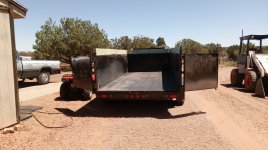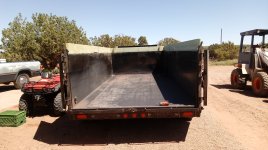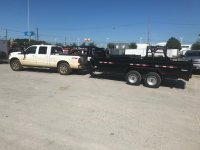LOL, plus one on the tailgate being down.
Keep in mind the warning about the gooseneck turning corners sharper than a bumper pull. The gooseneck does not follow in the same tracks as the truck. Have known several cases of tires hitting the culvert ends on a drive entrance and tires getting cut and rims bent. Same for curbs at intersections being a issue.
Keep a eye on the clearance between the goose NECK and the bed of your truck when crossing uneven terrain. ESPECIALLY when turning. Many have had the neck come into contact with the bed of the truck.
When backing up its real easy for the tail end of the truck to be way further out past the trailor than you are used to with bumper pull. It’s easy to make a much sharper turn with the gooseneck and so your truck will be completely out of line or track with the trailor. Make sure you do not back the truck into something as you back the trailor up. This sounds obvious but you will be surprised if your not careful.
Try to have a plug in the side wall of the bed of truck near the tailgate for the trailor to use. Regardless of where you plug it in be careful to keep the bed of the truck clear so things do not catch the cord for the lights and brakes. When backing tight turns its not unheard of to see the cord get into and hang up in the crack between the tailgate and corner of the bed. Same for going forward at times. If plug is down on the rear bumper make sure the slack in the cord (you need a lot for tight turns) does not get into or under a bumper hitch. Use a bungee cord or something really easy to stretch and fastened to the goose neck for any slack that might get tangled up.
Depending on the type of gooseneck hitch in the bed the safety chains can easily be to short when turning, especially on tight turns. The Curt type hitches is one that is a problem. The newer ones have the chain hook attachments some distance back and to the side of the gooseneck ball. BH type is less of a problem.
I know it sounds silly. CHECK the grease in the bearings ! Do not care that its new and just from the factory. Check the grease. If its a oil bath type axle make sure the end cap is tight. Not unusual to see improper greased bearings. After you drive and stop a few times check and make sure ALL of the brakes are working. The wheels will be of similar warmth to the touch if they are. Or use a temperature gun.
Make sure what ever type of fasteners keeps the loading ramps secure is always in. In fact just get a couple extras and keep them in the trailor tool box. Your going to need them sooner or later.....

Some of the new trailors have a safety pin that goes through the gooseneck after its adjusted to the right height for your truck. Use it. If yours does not have it, then make sure the bolts holding it in are tight and check them a couple of times the first few times you use the trailor. Have heard stories of the neck slipping when dumping.
Keep the gooseneck ball or socket greased a bit. Personally I think its a good idea. Some never do so guess its a matter of preference.
Personally I like to keep a 2x4 or something fastened to the top of the sides walls. That way when your loading something and your a bit off its a board getting beat up, not the top of your walls. Also when loading from the side its easy to pull up just a bit to far and have the tractor hit the side walls of the trailor.
Do you have power down on the dump ? If its gravity down type of bed lowering its possible to have dirt pile up when dumping. Then when you try to pull forward all the weight on the back of the trailor lifts the front of the trailor up. In a two wheel drive pickup its easy to be spinning tires as the weight comes off the rear. And since you cannot force the bed down, your stuck. Four wheel drive is handy for times like this.
Dump on a level surface. Be real careful moving with the bed up. Keep in mind materials can get stuck at the top of the bed and it becomes top heavy, tipsy and a problem if your moving or on a non level surface side to side. If you have D rings or other types of tie downs its common for some items to catch and hang up on them when dumping. It’s easy to weld on a tab to keep items deflected if needed.
Watch out for operators loading gravel or whatever. Some will want to keep the loader bucket up high and dump into the bed. They are used to dump trucks and heavy machinery. Chances are real good your trailor is not as well built.
WEAR THE DARN SEATBELT WHEN LOADING THE TRAILOR OR WHEN DRIVING THE TRACTOR ONTO THE TRAILOR. Your going to be operating with the bucket up high at the trailor. It’s easy to want to turn a bit or find a soft spot and then have a tractor tipping issue. Keep ballast on the back of the tractor!
Keep front tires on tractor aired up, probably to max. Same issue again. Your going to be operating with the bucket up high some and do not need a low tire issue.
So once again. Tailgate down, and watch the tires on turns since they will be turning tighter than the truck. Seatbelt !!!
I know it was a long post, some of it may seem obvious but posted just in case. Enjoy your new equipment




